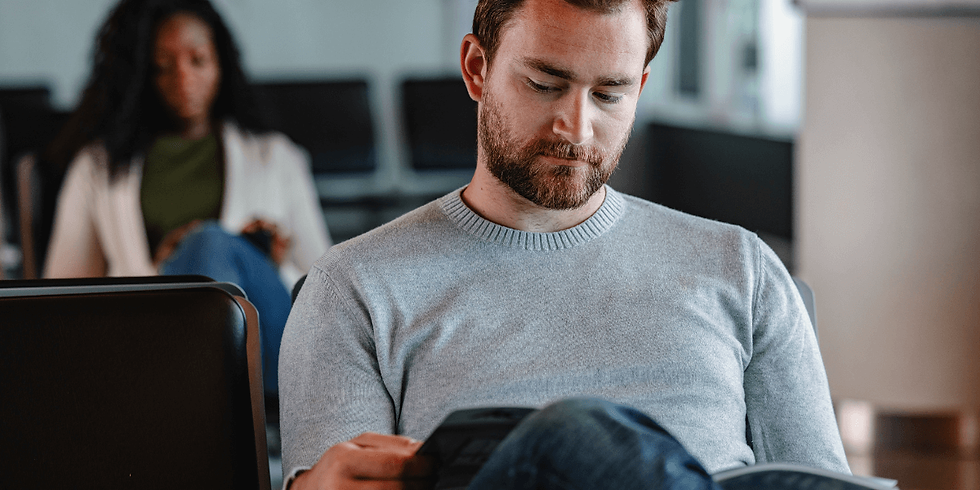Learn How to Manage Flight Anxiety
- Renz Quimosing
- Aug 19, 2024
- 10 min read

Flying can be an exciting way to travel, opening up new destinations and experiences. However, for many people, the thought of getting on a plane induces a sense of dread, especially if it is a long-haul flight. If this sounds familiar, you might have flight anxiety. Knowing how to manage flight anxiety can transform your travel experiences and make them much more enjoyable and less stressful for you and everyone else you travel with.
I have personally struggled with anxiety, and I know just how overwhelming it can be. My journey with anxiety has deeply informed my practice, and as an anxiety coach in NYC, I help clients face their fears and take control of their anxiety.
Let’s explore practical steps and techniques that can make flying a more comfortable experience for you.
Key Takeaways
Preparation and self-awareness are key to managing flight anxiety.
Understanding the mechanics of flying and practicing relaxation techniques can significantly reduce anxiety.
Seeking support from a life coach can provide personalized strategies and encouragement.
Understand Your Anxiety
Flight anxiety, also known as aviophobia, affects millions of people worldwide. It's a common issue that can turn the prospect of air travel into a daunting experience. Understanding this anxiety is the first step toward managing it effectively.
What is flight anxiety?
Flight anxiety refers to the fear or intense anxiety experienced before, during, or even after a flight. This type of anxiety manifests in various ways, from mild nervousness to severe panic attacks.
It’s not unusual to feel anxious about flying, as it involves relinquishing control and placing trust in the aircraft and crew.
Common symptoms and triggers
Recognizing the symptoms of flight anxiety is crucial for managing it. Common symptoms include:
Increased heart rate
Sweaty palms
Shortness of breath
Intense anxiety or panic attacks
Nausea
Trembling
A sense of doom or dread
Several factors can trigger flight anxiety, such as:
Fear of a plane crash
Claustrophobia or fear of confined spaces
Turbulence or unexpected noises
Previous negative experiences with flying
Fear of heights
Lack of control
Concerns about safety and security
Identify personal triggers
Being able to identify your specific triggers is essential to combat flight anxiety. Each person's experience with anxiety is unique, so understanding what specifically sets off your anxious feelings is important.
For some, it might be the enclosed space of the aircraft, while others might fear turbulence or the possibility of a plane crash.
Take time to reflect on past experiences and pinpoint what aspects of flying cause you the most stress. Once you identify these triggers, you can start developing strategies to manage them.
For instance, if turbulence is a trigger, learning more about how planes are designed to handle turbulence can help reduce your fear.
Addressing flight anxiety
Flight anxiety doesn’t only affect your ability to travel comfortably; it can also have broader implications for your mental health. Persistent anxiety can lead to avoidance behaviors, limiting your travel options and potentially affecting your personal and professional life.
Working with a mental health professional, such as a clinical psychologist or anxiety coach, can provide tailored strategies to help you manage your anxiety effectively.
Pre-Flight Preparation

Preparing for your flight can significantly reduce anxiety and make your journey much more manageable. Here are some practical tips to help you feel more at ease before you board the plane.
Learn about the mechanics of flying and safety measures
Knowing more about how planes work and the safety measures in place can greatly diminish those “what if” thoughts that fuel anxiety. Airplanes are marvels of engineering, designed to handle various flying conditions, including turbulence. Learning about these facts can help reduce your fear of flying.
For example, knowing that aircraft undergo rigorous safety checks and that turbulence is a normal part of flying can provide reassurance.
Practice breathing techniques
Practicing breathing techniques before your flight can help calm your nervous system and reduce anxiety levels. Here are three effective methods you can try:
Deep breathing: Inhale deeply through your nose, let your diaphragm expand, and then exhale slowly through your mouth. This helps regulate your heart rate and brings a sense of calm.
4-7-8 breathing: Breathe in through the nose for 4 seconds, hold your breath for 7, and exhale through your mouth for 8 seconds. This technique acts as a natural sedative for the nervous system.
Alternate nostril breathing: Use your thumb to cover your right nostril and breathe in through the left. Next, use your ring finger to close the left nostril and breathe out through the right. Repeat this process, which promotes balance and calmness in the body.
Practicing these techniques before your flight can make them easier to implement if you start feeling anxious during the flight.
Do visualization
Visualization is an effective tool to manage anxiety. By picturing yourself in a safe, calm place, you can create a mental escape from the stress of flying.
For example, imagine yourself on a serene beach, feel the warmth of the sun and hear the soothing waves. Alternatively, visualize a successful journey where you board the plane, enjoy a smooth flight, and land safely at your destination.
This technique can also be used during the flight. If you start to feel anxious, close your eyes and take a few deep breaths while picturing your calming scenario. This can help shift your focus from the anxiety-inducing aspects of flying to a more peaceful state of mind.
Another practical tip
Choose your seat wisely: Opt for an aisle seat if you feel claustrophobic or need to move around frequently. Being able to get up and stretch can help reduce feelings of confinement.
Preparing for your flight with these strategies can help you conquer flight anxiety and make the experience much more enjoyable.
At the Airport

Navigating the airport can be a significant source of anxiety, but with some preparation, you can make this part of your journey much smoother and more manageable.
Arrive early
Arriving at the airport early offers several benefits, particularly for anxious flyers. Giving yourself ample time to check in, go through security, and find your gate can significantly reduce stress. When you’re not rushed, you have the opportunity to handle any unexpected issues calmly, such as long lines or changes in your flight’s status.
Additionally, arriving early allows you to acclimate to the airport environment, giving you time to practice your breathing techniques and stay relaxed.
Distraction tools
Bringing along engaging distractions can help keep your mind occupied and reduce anxiety. Here are some suggestions:
Books: Choose a captivating novel or an engaging non-fiction book that can hold your attention.
Movies and TV shows: Download your favorite movies or TV series on your device. Watching something familiar can be comforting and distracting.
Music and podcasts: Create a playlist of calming music or download interesting podcasts. Music can soothe your nerves, while a podcast can provide an engaging diversion.
Games and puzzles: Mobile games, crossword puzzles, or Sudoku can help keep your mind focused on something other than your anxiety.
Other tips
Comfortable clothing: Wear comfortable clothes, such as leggings and a soft sweater, to help you feel more relaxed. Layering is a good idea in case the airport or plane is too cold or too warm.
Healthy snacks: Bring along some healthy snacks to keep energy levels stable and avoid the irritability that can come from being hungry.
With a bit of planning, you can set yourself up for a smoother, more relaxed journey.
During the Flight

Once you're on the plane and feeling mid-flight anxiety creep in, there are several strategies you can use to manage your anxiety and ensure a calmer, more pleasant flight experience.
Mindfulness exercises
Mindfulness techniques can help you stay present and calm during the flight. Here are a few exercises to try:
Deep breathing: Focus on your breath. Inhale deeply through your nose, hold for a few seconds, and exhale slowly through your mouth. Repeat this several times until you feel your anxiety lessen.
Body scan: Close your eyes and visualize your body from head to toe. Take note of any areas of tension and consciously relax them.
Five senses exercise: Use your five senses to ground yourself. Identify five things you can see, four you can touch, three you can hear, two you can smell, and one you can taste.
Apps like Calm offer guided meditations and relaxation exercises specifically designed for in-flight anxiety. Download these apps before your flight so you can access them offline.
Separate fear from danger
It’s vital to remember that feeling anxious doesn’t mean you are in danger. Anxiety can trick your brain into thinking there is a real threat when there isn’t. Remind yourself that turbulence, strange noises, and even feeling anxious are all normal parts of flying and not indicators of danger. Reassure yourself with facts: flying is one of the safest modes of transportation.
Handling turbulence
Turbulence can be a major trigger for anxiety, but understanding what it is can help you stay calm. Turbulence is simply air movement that the plane passes through, similar to driving on a bumpy road. Planes are designed to handle turbulence, which is a common and safe part of flying.
Here are some tips for managing anxiety during turbulence:
Focus on your breathing: Use deep breathing or the 4-7-8 technique to keep yourself calm.
Visualize a calm place: Close your eyes and imagine yourself in a safe and relaxing environment, like a beach or your favorite room at home.
Progressive muscle relaxation: Slowly tense and then release different muscle groups throughout your body, starting with your toes and moving your way up to your head. This helps release physical tension and can distract your mind from anxiety.
Post-Flight Strategies

Managing flight anxiety doesn’t end once you land. Post-flight strategies are necessary to help you process your experience and prepare for future flights. Here are some effective techniques to consider:
Debrief
Reflect on your flight experience. Take some time to think about what strategies worked for you and which ones didn’t. Consider how you felt at different stages of the flight and identify any triggers that caused anxiety. This reflection will help you understand your anxiety better and improve your coping strategies for future flights.
Journal experiences and feelings post-flight
Writing down your thoughts and feelings after a flight can be incredibly therapeutic. Journaling allows you to process your emotions and gain insights into your anxiety patterns. Here are some prompts to get you started:
What were your main sources of anxiety during the flight?
Which coping strategies helped you the most?
How did you feel before, during, and after the flight?
What positive experiences did you have?
What will you do differently next time?
By keeping a record of your experiences, you can track your progress over time and see how you’re improving.
Go for exposure therapy
Exposure therapy involves gradually exposing yourself to the source of your anxiety in a controlled way to reduce sensitivity to triggers. Each flight you take is an opportunity to practice this. Start with shorter flights and gradually work your way up to longer ones.
Repeatedly facing your fear in manageable steps can help you build confidence and reduce anxiety.
Additional tips
Celebrate small wins: Acknowledge and celebrate the steps you’ve taken to manage your anxiety, no matter how small. Each flight is a victory and a step closer to conquering your fear.
Stay prepared: Continue practicing your relaxation techniques, such as deep breathing and visualization, even when you’re not flying. This helps reinforce these skills, so they become second nature.
Seeking Professional Help
While self-help strategies can be highly effective, sometimes professional help from a life coach can make a significant difference in managing flight anxiety. Here’s when to consider seeking assistance and an overview of some effective coaching approaches.
When to consider coaching
If flight anxiety severely impacts your life, such as avoiding travel for important events or experiencing panic attacks, it might be time to seek help from a life coach. Here are some signs that you could benefit from coaching:
Your anxiety is persistent and severe.
Self-help strategies aren’t providing enough relief.
Your fear of flying limits your personal or professional life.
You experience significant anticipatory anxiety before flights.
Symptoms like cold sweats, increased heart rate, and catastrophic thoughts are overwhelming.
Recognizing when to seek professional help is vital for conquering flight anxiety and improving your quality of life.
Coaching approaches
Cognitive Behavioral Coaching (CBC)
Cognitive Behavioral Coaching is a highly effective method for dealing with anxiety, including flight anxiety. The approach identifies and changes negative thought patterns and behaviors. Here’s how CBC can help:
Identify triggers: CBC helps you pinpoint the specific thoughts and situations that trigger your anxiety.
Challenge negative thoughts: You learn to challenge and reframe catastrophic thoughts, reducing their power over you.
Develop coping strategies: CBC provides practical techniques to manage anxiety, such as breathing exercises and gradual exposure.
Exposure techniques
Exposure techniques involve gradually facing your fear in a controlled manner. This process helps desensitize you to the triggers of your flight anxiety, reducing your overall fear response. Starting with smaller, manageable steps, such as watching videos of flights or visiting an airport, can lead to gradual improvements.
Mindfulness and relaxation techniques
Incorporating mindfulness practices and relaxation techniques can significantly reduce anxiety. These approaches help you stay present and calm during stressful situations:
Mindfulness-based stress reduction (MBSR): This approach uses mindfulness practices to help you stay present and reduce anxiety.
Progressive muscle relaxation: This technique requires tensing and then relaxing different muscle groups in your body.
Support and accountability
Working with a life coach will provide you a structured and supportive environment. A coach offers guidance, encouragement, and accountability, helping you stay committed to your goals and strategies for managing flight anxiety.
Transform Your Fear into Freedom
Empowerment through preparation and self-awareness is within your reach. By understanding your flight anxiety and employing practical strategies, you can conquer your fear of flying and embrace the freedom of travel. Remember, you don’t have to do it alone.
As someone who has navigated the challenges of anxiety, I’m here to guide and support you every step of the way. Together, we can turn your apprehension into confidence.
Contact me and schedule your free 15-minute phone consultation. Let's start you on your path to anxiety-free flying.
Frequently Asked Questions
How can I overcome fear of flying?
Overcoming the fear of flying involves understanding your triggers, practicing relaxation techniques, and gradually exposing yourself to flying situations. Working with a life coach will provide you personalized strategies and support to help you manage your anxiety.
What can I take for fear of flying?
Rather than medication, consider using natural strategies like deep breathing exercises, mindfulness, and visualization techniques. These methods can calm your nervous system and manage anxiety effectively during flights.
How to get rid of fight or flight anxiety?
To manage fight or flight anxiety, focus on techniques to ground yourself, such as deep breathing, progressive muscle relaxation, and mindfulness exercises. These strategies can help regulate your body's stress response and reduce anxiety.
How do I distract myself from anxiety on a plane?
Bring along engaging distractions like books, movies, music, or puzzles. Focusing on these activities can help keep your mind occupied and reduce anxious thoughts during the flight.







Comments